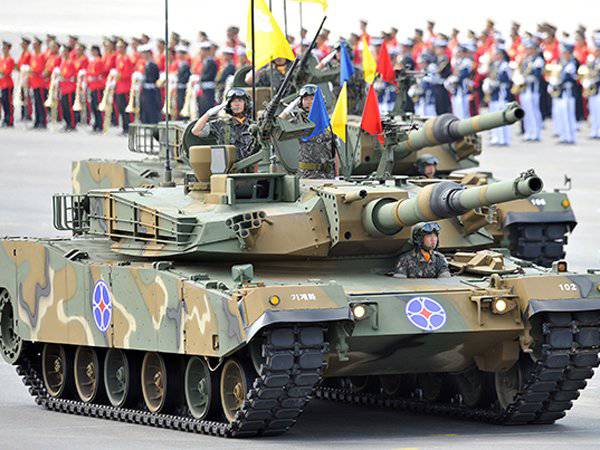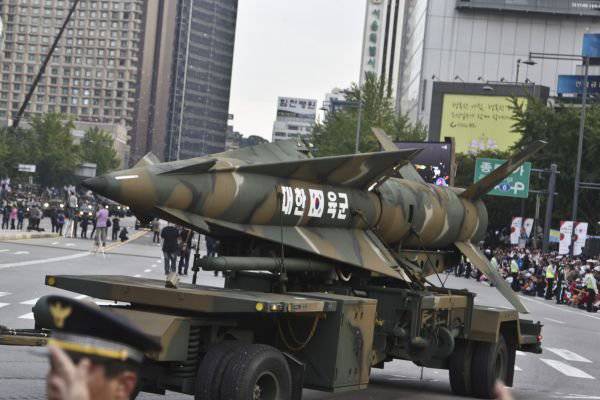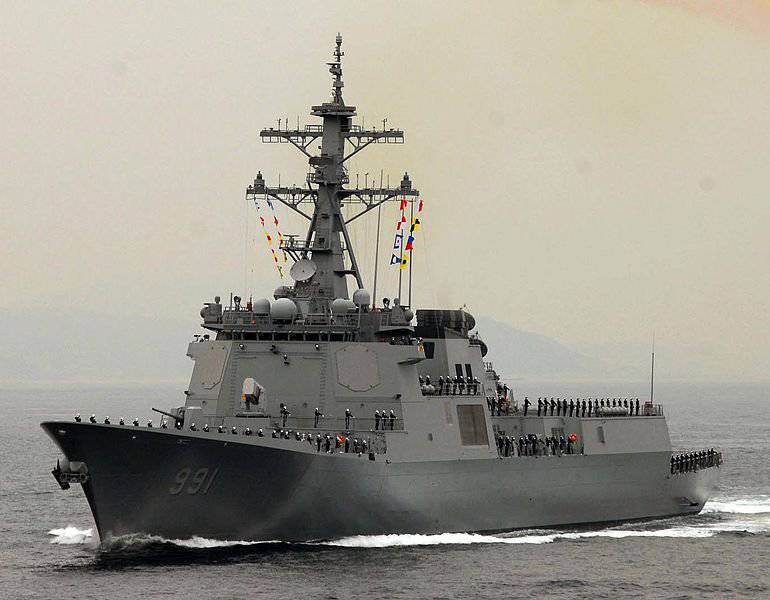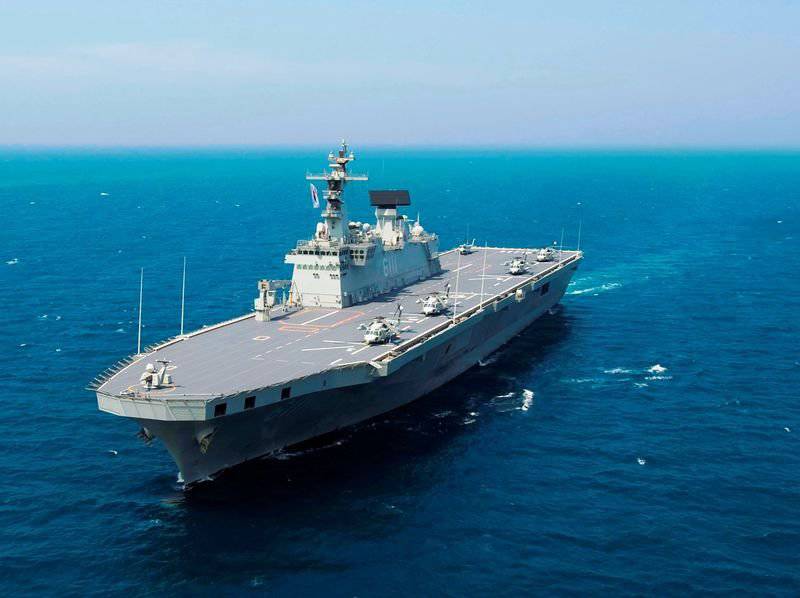Pacific frontier: South Korean "ambush regiment"

Another hotbed of war in the Asia-Pacific region is the problem of divided Korea. The Republic of Korea still retains the properties of an occupied country. Korean War 1950-1953's. led to the fact that the peninsula remained divided into zones of influence of the USSR and the USA. Much later, the Soviet Union was killed, but American troops remained in South Korea as a peacekeeping (occupation) contingent.
Korea is an artificially divided state. South Korea has achieved great success in the economy and the development of national armed forces, but the United States still holds large military contingents there. The South Korean armed forces were to become independent only by 2015 (now this date is in doubt, Seoul asks to wait). At present, they are subordinated to the president and the government only in administrative order, and in the operational (command of military operations) they are part of the United States and Republic of Korea armed forces. Accordingly, the high command of the South Korean forces belongs to Washington.
North Korea is more independent, but it has become a kind of "testing ground" for practicing the construction of a pseudo-socialist totalitarian society (this is one of the scenarios for all of humanity). Therefore, despite all the sharp movements of Pyongyang, the DPRK still exists. It is very symbolic that the current top leader of the DPRK, Kim Jong-un, studied in Bern, Switzerland, and is a lover of pop culture (with its restriction in North Korean society). If necessary, this “leader” will launch the “perestroika” process and eliminate the North Korean testing ground.
Currently, the existence of the DPRK is beneficial to the United States, since it allows to justify its military presence in South Korea and partly in Japan. It should also be noted that the DPRK is not an unequivocal ally of China: they have recently had rather tense relations.
North and South are well aware that during the Korean War they turned out to be pawns in the chess game of great powers. The war did not end with the signing of a peace agreement: only a truce was established, which lasts to this day. The current state of the "temporary truce" instead of a full-fledged peace treaty between the DPRK and South Korea is a direct merit of the United States. The Americans are doing everything to prevent a peace agreement from being concluded and progress towards the reunification of a divided nation. It is clear that they do it not openly. Every time Pyongyang is trying to conclude a peace treaty, the Americans surround the possibility of signing this agreement with such political demands that do not give North Korea room for maneuver. Interestingly, the next “exacerbation of the situation” on the Korean Peninsula always happens when negotiations between the South and the North begin to produce results. Americans at such moments begin to conduct provocative military exercises that are in the nature of a preemptive strike on the "criminal dictatorial regime."
North Korea’s reaction to such provocations is predictable: joint programs are being curtailed with the South, troops are on full alert. The actions of the DPRK immediately swell the Western media. The US is responding with new teachings and concentration of ships and troops. What for? The answer is simple. The United States does not need peace on the peninsula and a united Korea. Provocations (right up to the strange sinking of the South Korean ship), intrigue and hysteria in the media, distorting reality, are US instruments.
Recently, Washington has been trying to drag South Korea into a program to create a global missile defense system and an anti-Chinese coalition. Thus, at present, a scandal is unwound in South Korea related to the decision of Seoul to agree to expand the powers of the Japanese armed forces, provided that the South Korean government will be consulted in the event of sending Japanese troops to the Korean Peninsula. Tokyo has recently insisted that Japan be allowed to send its military forces abroad within the framework of the UN-recognized right to collective self-defense. The other day in Seoul they decided that they would not be able to resist the agreement adopted in Washington and Tokyo to expand the powers of the Japanese Self-Defense Forces and decided to come to terms with the "inevitable", bending under the Americans. A senior official said: “All this is a matter of bilateral relations between the United States and Japan. We can only demand that this does not hurt our interests and sovereignty. ” This caused a flurry of criticism in the South Korean media. Koreans remember the atrocities and violence of the Japanese military during the years of occupation.
At the same time, Seoul, according to local media, is susceptible to Washington's persuasion of a global missile defense system. At least, the South Korean defense department intends to purchase precisely those interceptor missiles, which are key components in the case of South Korea joining the US missile defense system. The official authorities refute this by speaking of the creation of a national missile defense system. Seoul recently announced a desire to create a Kill Chaine system for 2016, designed to strike North Korea’s missile targets. In 2014, 1 trillion 119,1 billion won (about 1 billion 110 million dollars) was allocated for the creation of a national missile defense system and the Kill Chin system. By the beginning of 2020, Seoul wants to deploy its own missile defense system - KAMD (Korea Air and Missile Defense). Seoul plans to strengthen its air and missile defense system. Currently they are going to introduce the PAC-3 Patriot complexes, replacing the PAC-2 currently in service with South Korea. South Korea asked the US to sell 112 Patriot interceptor missiles totaling more than 400 million dollars.
However, these missiles have an effective ceiling of no more than 30 kilometers, so the complexes should be the basis of the short-range anti-missile defense. Long-range defense can be built up by Terminal High Altitude Area Defense (THAAD) missiles manufactured by Lockheed Martin. Their interception height is up to 150 km, with a range of 200 km. South Korean Defense Ministry spokesman Kim Min Sok said that "the Defense Ministry is exploring various opportunities to improve the ability to neutralize the North Korean missile and nuclear threat." And the vice-president of the American company Lockheed Martin confirmed that South Korea had expressed interest in acquiring the THAAD complexes. At the same time, there are rumors that Seoul is ready to purchase SM-3 anti-missiles for the maritime component of the missile defense system. Currently, South Korean destroyers are armed with SM-2 interceptor missiles. In addition, the Korean missile defense plans to use the capabilities of American early warning satellites. Therefore, the Korean media, some experts and deputies suspect that the government did make a deal with the United States on missile defense.
The South Korean government does not want to accept the responsibility of command over the combined forces on the Korean Peninsula and wants to postpone this event to a later date. Seoul believes that it is not yet ready for such a decision. Washington also announced the need to transfer command by the end of 2015, but quite recently, for some reason, decided to cede to Seoul in this matter. In this regard, the Korean public suspicions arose that there was a deal between the United States and the Republic of Korea along the lines of “command in exchange for missile defense”: Seoul receives a delay in the transfer of command, and joins the global missile defense system of the United States as payment. In addition, there is a suspicion that speaking of national missile defense and taking steps to create it, Seoul de facto creates such missile defense, which can easily be integrated into the US.
South Korea has quite modern armed forces and a significant military budget - 31 billion dollars (2012 year). Economic well-being allows developing the national military industrial complex and purchasing the most modern weapons from Western countries. In 2012, the “Basic 12-30 Reform Plan” was approved in South Korea. He identified the main directions of development and reform of the South Korean armed forces for up to 2030 year. Seoul plans to spend about 171 billions of dollars on the development of the sun. Taking into account the demographic situation in Korea, the size of the Armed Forces will be reduced from 636 thousand people to 522 thousand people by 2022 year. But the decrease in the number of bayonets will be compensated by the buildup of firepower and the number of weapons, the acquisition of newer, more sophisticated and high-precision equipment, as well as automation and computerization of the Armed Forces. It should also be said that the number of the Air Force and Navy will not be reduced. In the Army, by the year 2020 they will form a new subunit - a special mountain rifle regiment, which will have to neutralize the North Korean sabotage units in the highlands of the South. Taking into account the numerous attacks on websites and computer networks of government institutions in South Korea, Cyber Command created in 2010 will double (to thousand people).
Especially high hopes are pinned on rocket armament. In September, 2012, South Korean President Lee Myung-bak approved the “Medium-Term National Defense Development Plan in 2013-2017” proposed by the Ministry of Defense. The missile arsenal should contain the nuclear potential of North Korea and be a response to the long-range artillery of the DPRK, which holds the South Korean capital at gunpoint. With the full implementation of the plan, the South Korean missiles must destroy the 70% of the North's firepower within a day, covering all the known DPRK 25 large missile bases, nuclear facilities and main artillery batteries. For this they are going to buy up to 900 missiles, primarily ballistic ones. All in service should be up to 1700 missiles. Most of the arsenal will be ground-to-ground missiles "Henmu-2" and "Henmu-2В", "Henmu-3" (models A, B, C).
In 2000, the “Henmu-2A” rocket appeared with a radius of 300 kilometers. This development of the Henmu-1 rocket is a two-stage solid propellant ballistic rocket of the earth-to-earth class. The first successful launch of the rocket was made in 1985 year. System length - 12, 5 m (second stage - 8,1 m), diameter - 80 centimeters (second stage - 53 centimeter), wingspan - 3,5 m (1,8 m) kg - 4 850 kg (2505 kg), maximum speed - 3,65 speed of sound, maximum flight altitude - 46 km, range - 180 km, warhead - up to 500 kg. Accuracy of defeat - 100 meters, all living things are destroyed within a radius of several hundred meters. By 2009, the company created the “Henmu-2B” with a range of 500 km. The "Henmu-2A" and "Henmu-2В" warheads remain the same. But at the expense of damaging elements, the area of damage has increased, and the accuracy has been increased: instead of an error in 100 meters - 30 meters. South Korea already has all the capabilities to create missiles with 1000-km radius of action and 1 ton payload (this will cover any point in the DPRK). But here Washington objects. The development of missile technology in South Korea inhibits the United States. This is very annoying Southerners. Especially their military. By the way, that is why the Americans refused to help the South in creating a national space program. In the US, they fear that Southerners will taste and eventually begin to create their own intercontinental ballistic missiles (ICBMs). South Korea’s missile capability also annoys Japan and China.
Americans did not set limits on cruise missiles. Therefore, Seoul has a “Henmu-3C” with a range of 1500 km. True, cruise missiles fly slower, they are easier to intercept, the force of destruction below ballistic missiles. But there are also advantages: accuracy (the error is 1-3 meters) and flight range. The first cruise missile "Henmu-3" began to be adopted in 2006-2007. The Henmu-3А has a radius of up to 500 km, the Henmu-3В is up to 1000 km, and the Henmu-3С is up to 1500 km. Henmu-3 length is 6 m, diameter is 60 centimeters, gross weight is 1,5 tons, warhead weight is 500 kg, fuel weight is 400 kg.
It is obvious that if the treaty with the United States on limiting the possibility of missiles is revised, then the South will be able to create a ballistic missile with a range of 1-2 thousand km and a warhead of up to 1 ton in a short time. The US is already taking steps in this direction. Washington agreed to a partial lifting of restrictions that were imposed on Seoul in terms of the range of ballistic missiles, as well as the creation of unmanned aerial vehicles (UAVs). Now southerners can create ballistic missiles with a range of up to 800 km and heavy Drones.

In the field of the Air Force and Navy, the South is currently building up military capabilities in several key areas at once. Now the question of the purchase of 60 fighters. Initially, Seoul was inclined to buy the Boeing F-15 Silent Eagle fighter, but then drastically changed course. Experts are currently talking about the possibility of acquiring a mixed fleet: 20 fighter jets (F-15 or Typhoon) and 40 F-35 to equip three squadrons (20 machines). In this case, there is a high probability that South Korea will acquire the F-15 because of its proximity to the 60 F-15K that are already in service with the Air Force. This will strengthen the combat power of the Air Force at the expense of the F-15, since the F-35 can only be obtained by the 2022 year. The Koreans themselves are working on a program to develop an advanced multi-role fighter - KAI KF-X (Korea Aerospace Industries KF-X). Seoul plans to create a national fighter of the 2020 ++ generation by 4. In order to increase the impact capabilities of the ground forces, South Korea will buy Apache Guardian attack helicopters AH-36E from the USA, which the Boeing Corporation admits.
As part of the military reform, the Air Force will create an Air Information Center for 2017. The center will monitor reconnaissance aircraft, unmanned aerial vehicles, early warning and control systems. His main task is to collect information on the peninsula. By 2019, the Satellite Tracking Center will be established (aerospace command). His task is to monitor, study and monitor the activities of satellites of foreign countries that monitor the Korean Peninsula. In the future, based on this Center, aerospace troops may be deployed. Here, much depends on the fate of the civilian program for the development of near space (very ambitious projects).
In the spring of 2012, South Korea received the last of the four CASA CN-235 maritime patrol aircraft destined for the coast guard. In May, the South Korean Defense Ministry approved the purchase of 2013 new coastal patrol aircraft (they will spend up to 20 million dollars) on 900. Koreans choose between the European Airbus C-295MPA patrol aircraft, the American Boeing P-8 Poseidon and the Lockheed Martin SC-130J Sea Hercules. At the same time, the Korean military are implementing a program to modernize the existing fleet of patrol aircraft - the 16 patrol aircraft P-3C Orion. This program will be completed by 2016 year. This will increase the capabilities of the South Korean armed forces in the field of anti-ship and anti-submarine warfare. South Korea’s priority programs also include the purchase of observation and reconnaissance aircraft. In particular, Seoul is considering the possibility of buying from the US several S-3 Viking deck-based anti-submarine aircraft, which the Americans have mothballed. The South Korean Navy can buy up to 20 such aircraft.
Given the fact that South Korea is a maritime power, great attention is paid to naval armaments. Seoul has a serious and modern Navy, the core of which are: 3 destroyer of the type "Quangeto Tevan" project KDX-1 with a full displacement of 3900 tons, they were commissioned in 1998-2000 years; The 6 squadron destroyers of the “Chunmugon Li Sunsin” type of the KDX-II project with a full displacement of 5520 tons were put into operation in 2003-2008; 3 destroyer of the type “King Shodzhon the Great” project KDX-3 with a full displacement of 10 290 tons, put into operation in 2008-2012. These destroyers are analogous to American destroyers of the URO-type "Arly Burke". Thus, South Korea is the third country in the Asia-Pacific region, which adopted the Ajis warships. The Navy plans in the near future to get three more ships of this type, and by the year of 2026 to bring their number to 12 units. In addition, in the period 2020-2026. South Korean fleet plans to get 6 Korean destroyers of a new generation (KDDX or project KDX-IIIA).

Squadron type "King Shodzhon the Great."
The South Korean Navy also has 9 submarines of the German-built 209/1200 type with a displacement of 1400-1500 tons. They joined fleet in 1993-2001 In addition, South Korea has signed two contracts with Germany for the supply of 9 Type 214 submarines. The first series of three submarines is already in service. Displacement of submarines - 1860 tons. The second series of six submarines should be delivered by 2018. At the end of 2012, the South Korean corporation Daewoo Shipbuilding & Marine Engineering (DSME) received a contract worth $ 1,56 billion to build for the South Korean Navy two large non-nuclear submarines of the national project KSS-III (Jangbogo III) with a displacement of more than 3000 tons. The fleet should receive submarines by 2022. In total, they plan to build 9 submarines of this project. These submarines will have vertical launchers for cruise missiles with a range of up to 1,5 kilometers. By 2015, they plan to create a new Submarine Command.
At the beginning of the 2013, the South Korean Navy took the lead frigate Incheon FFX-I class. Displacement 114-meter frigate is 3250 tons. Frigates of this class should replace the 9 of the Ulsan-class light frigates in service with the Navy, which were commissioned in the 1980-1992, as well as the old corvettes. The FFX class frigate is a multipurpose warship that is equipped with advanced weapon systems, allowing it to be used for anti-aircraft, anti-submarine, anti-ship combat and reconnaissance in coastal zones. It has improved air defense capabilities and anti-enemy submarines. 18 July 2013 of the year was launched the second frigate of the project FFX "Gyenggi". It will be given to the Navy in 2014. By the 2015, the 6 or 7 frigates of the first series will be built. The second batch will consist of 6 ships. Then the third series will be built. In total, the 2020 year plan to put into operation before the 20 frigates. And by 2026 year - to 24 ships. It is believed that the ships of the 2 party will receive vertical launch installations for nationally developed long-range anti-aircraft missiles and long-range cruise missiles.
In 2007, the multipurpose Tokto-class amphibious ship of the LPX project was introduced into the fleet. Full displacement - 18 thousand tons, length - up to 200 meters. Air Group - 10 helicopters. In the future, they plan to build two more helicopter carriers of this type. It is possible to base on the "Dokdo" aircraft with a short takeoff and vertical landing F-35B. In October 2013 of the year in the South Korean port of Pusan launched the first landing ship of the national development, the Chonvanbong, with a displacement of 3,5 thousand tons and 126 meters in length. Thus, the Korean Navy increased their capabilities for amphibious operations.
The appearance of the first aircraft carrier "Liaoning" (the former "Varyag") in China’s arms seriously increased Seoul's concern about the growing power of Beijing at sea. South Korea is concerned about the build-up of combat capabilities of the Navy of China and Japan. In this regard, South Korean media demand that the construction of new Korean warships and submarines be intensified. South Korean experts noted that the emergence of a Chinese aircraft carrier changed the balance of power in the region, and could eventually turn into a threat to national interests, since South Korea does not have adequate deterrent forces at sea. Seoul is also concerned that Beijing plans to put into operation several aircraft carriers. According to US intelligence, the People's Republic of China can launch a second aircraft carrier as early as 2014. And by 2020, China will have 4-6 carrier strike groups. It is also possible that the second Chinese aircraft carrier will be equipped with nuclear power plants.
Therefore, in South Korea, they are increasingly demanding that the build-up of their own naval forces be intensified in order to somehow contain the growth of the sea power of the PRC and Japan. Currently, in South Korea, the concept of using light aircraft carriers, which can be commissioned there by the 2036 year, is being studied. According to a member of the National Assembly Defense Committee, Chang Hee-su, given the buildup of the combat power of the Chinese Navy and Japan, in order to resolve potential territorial disputes with neighboring countries, Seoul should adopt aircraft carriers as soon as possible. According to the parliamentarian, the South Korean military are planning to implement a project to increase the fleet's strike power in three stages. By the year 2019, the second Tokdo class helicopter carrier will be added to the fleet. If necessary, it can be equipped with aircraft with a short takeoff and vertical landing from the US, British or Spanish armed forces. At the second stage, an amphibious helicopter carrier of the type of the Spanish universal amphibious assault ship “Juan Carlos I” with a displacement of 27 thousand tons will be introduced into the Navy. This is a strategic force projection ship, which has a springboard for increasing the combat load of airplanes with a shortened takeoff. In the armament of the ship can be aircraft such as Harrier, F-35. The air group of the ship includes up to 30 airplanes and helicopters. At the final stage in 2028-2036. South Korea can build two light aircraft carriers with a displacement of about 30 thousand tons. Such an aircraft carrier will be able to carry the air group in 30 aircraft.
Another response from South Korea to the growing threat from China and Japan is the creation of a new “Strategic Mobile Squadron“ Tokto-Iodo ”with a base on Jeju Island. The squadron will be a kind of rapid reaction force unit that will be able to respond to the threat in the area of Iodo Island (a territorial dispute with China) and the Dokto Archipelago (a conflict with Japan). This strike squadron will include KDX-I, KDX-II, KDX-III class destroyers, patrol boats, large landing ships, auxiliary vessels and submarines. In addition, a new separate marines regiment will be deployed on Jeju Island, and the Marine Corps itself will be strengthened with its own air units (36 transport-combat and 16 attack helicopters).

"Dokdo".
To be continued ...
- Alexander Samsonov
- Pacific Rim: The Awakening of the Samurai Spirit in Japan
Pacific frontier: South Korean "ambush regiment"
Pacific frontier: Chinese "fortress"
Pacific frontier: Chinese "fortress". Part of 2
Information